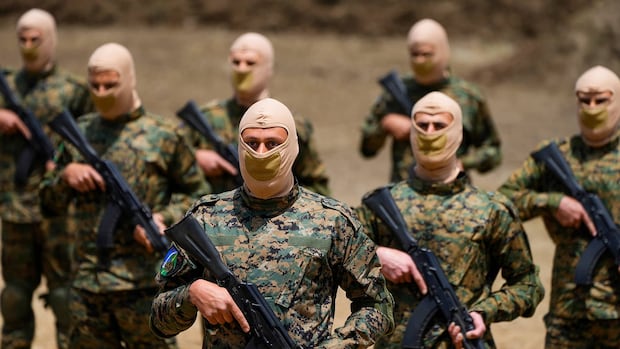Lebanon’s Hezbollah has new weapons and intelligence capabilities that could help it target more critical positions deeper inside Israel in case of an all-out war, the militant group’s leader warned on Wednesday.
Hassan Nasrallah’s comments came as the months-long cross-border conflict simmering between Hezbollah and Israel appears to be reaching a boiling point, and a day after a top U.S. envoy met Lebanese officials in his latest attempt to ease tensions.
“We now have new weapons. But I won’t say what they are,” Nasrallah said in a televised address commemorating a top Hezbollah commander killed in an Israeli airstrike in southern Lebanon last week. “When the decision is made, they will be seen on the front lines.”
Hezbollah has used locally made explosive drones for the first time since the start of the Israel-Hamas war in Gaza in October, as well as surface-to-air missiles to chase off Israeli jets.
Nasrallah said in 2021 that Hezbollah has 100,000 fighters but now claims the number is much higher, without elaborating. He also said he has rejected offers from allied countries and militias in the region that could add tens of thousands to his ranks.
Israeli plans for Lebanon ‘approved and validated’: army
A nearly 10-minute-long video allegedly filmed by a Hezbollah surveillance drone and released Tuesday shows parts of Haifa — a city far from the Israel-Lebanon border. In his speech Wednesday, Nasrallah said Hezbollah has much more footage — an apparent threat it could reach sites deep in Israel.
Nasrallah said “there will be no place safe from our missiles and our drones” in Israel, and that the group also had “a bank of targets” it could select for precision strikes.
Israel’s military chief, Lt.-Gen. Herzi Halevi, visited Israeli air-defence soldiers near the border with Lebanon on Wednesday, saying Israel was aware of Hezbollah’s capabilities demonstrated in the video and has solutions for these threats.
“We of course have infinitely greater capabilities,” he said. “I think the enemy is only familiar with a few of them and [we] will confront them at the right time.”
WATCH | Iran’s Axis of Resistance and its role in the Israel-Hamas war:
Sitting on the edges of the Israel-Hamas war is what’s been called the Axis of Resistance, a loose coalition of Iran-backed entities, including Hezbollah, Hamas and the Houthis in Yemen. CBC chief correspondent Adrienne Arsenault breaks down the conditions that could cause the group to engage in a wider war and the firepower behind it.
Hezbollah has been exchanging strikes with Israel almost daily since the war in Gaza erupted on Oct. 7 after a Hamas-led attack in southern Israel, with the aim to pull Israeli forces away from the embattled Gaza Strip.
Hezbollah’s attacks escalated after Israel expanded its offensive into the southern Gaza city of Rafah in May, and spiked further in June after an Israeli strike killed high-ranking Hezbollah commander Taleb Sami Abdullah, the most senior militant killed so far during the Israel-Hamas war.
The Israeli army on Tuesday said it has “approved and validated” plans for an offensive in Lebanon, although the decision to actually launch such an operation would have to come from the country’s political leadership.
Cyprus warned
The warnings by both sides followed a visit by U.S. President Joe Biden’s senior adviser Amos Hochstein, who met with officials in Lebanon and Israel in his latest attempt to de-escalate tensions. Hochstein told reporters in Beirut on Tuesday that it was a “very serious situation” and that a diplomatic solution to prevent a larger war was urgent.
Nasrallah said a wider war with Lebanon would have regional implications and that Hezbollah would attack any other country in the region that assisted Israel in the war effort, citing Cyprus, which has hosted Israeli forces for training exercises. He suggested Cyprus might allow Israel to use its bases in event of a wider war.
In response, Cypriot President Nikos Christodoulides said his island nation “is in no way involved” in any military operations in the region. Cyprus is “part of the solution, not part of the problem” he said, pointing out the Cyprus-Gaza maritime corridor used to deliver aid to the Palestinian territory.
Hundreds killed near Lebanon border since Oct. 7
Israel views Hezbollah as its most direct threat, and the two fought a 34-day war in 2006 that ended in a stalemate. Hezbollah’s military capabilities have grown significantly since then, and the United States and Israel estimate the group, along with other Lebanese militant factions, has about 150,000 missiles and rockets. Hezbollah also has been working on precision-guided missiles.
Hezbollah said at least four of its fighters were killed Wednesday in Israeli strikes as Hochstein returned to Israel for a new round of meetings there.
Lebanese state media reported the strikes along the border and near the coastal city of Tyre, about 30 kilometres away. The Israeli military said two Hezbollah launches damaged several vehicles in northern Israel.
LISTEN l Beirut-based journalist Rebecca Collard on Hezbollah’s presence in Lebanon (Nov. 1):
Front Burner20:15What is Hezbollah?
Kamel Mohanna, the head of the Amel Association, a nongovernmental organization providing health services in different areas of Lebanon, said the association health centre in the town of Khiam was hit and damaged by the Israeli shelling.
Israeli strikes have killed more than 400 people in Lebanon, most of them Hezbollah and other militants, but also over 80 civilians and non-combatants. In northern Israel, 16 soldiers and 11 civilians have been killed by strikes launched from Lebanon.




